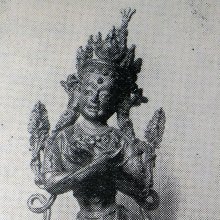Shunya, Śūnya, Śūnyā, Śunya: 27 definitions
Introduction:
Shunya means something in Buddhism, Pali, Hinduism, Sanskrit, Jainism, Prakrit, the history of ancient India, Marathi, Hindi. If you want to know the exact meaning, history, etymology or English translation of this term then check out the descriptions on this page. Add your comment or reference to a book if you want to contribute to this summary article.
The Sanskrit terms Śūnya and Śūnyā and Śunya can be transliterated into English as Sunya or Shunya, using the IAST transliteration scheme (?).
Alternative spellings of this word include Shuny.
Images (photo gallery)
In Hinduism
Natyashastra (theatrics and dramaturgy)
Source: Wisdom Library: Nāṭya-śāstraŚūnyā (शून्या, “vacant”) refers to a specific “glance” (dṛṣṭi), according to the Nāṭyaśāstra chapter 8. This is a type of glance that expresses a ‘transitory state’ (saṃcāribhāva). There are a total thirty-six glances defined.
Source: archive.org: The mirror of gesture (abhinaya-darpana)A type of glance (or facial expression): Śūnya (vacant): eyelids level, pupils visible, motionless, gaze vacant. Usage: misunderstanding (bāhyārtha-grahaṇa).
Source: archive.org: Natya ShastraŚūnyā (शून्या).—A type of glance (dṛṣṭi) expressing a transitory state (saṃcāribhāva);—The Glance which is weak and motionless and in which the eyeballs and the eyelids are in ordinary position (lit. level), and which turns to the space and is not attentive to external objects is called Śūnyā (vacant).
Uses of Śūnyā (vacant)—in anxiety and paralysis (motionlessness).
Source: Shodhganga: Elements of Art and Architecture in the Trtiyakhanda of the Visnudharmottarapurana (natya)Śūṇyā (शूण्या) refers to one of the Thirty six kinds of Glances (dṛṣṭi) or “proper accomplishment of glances” (in Indian Dramas), according to the Viṣṇudharmottarapurāṇa, an ancient Sanskrit text which (being encyclopedic in nature) deals with a variety of cultural topics such as arts, architecture, music, grammar and astronomy.—Dṛṣṭi is very important in a dance form. The appropriate movements of eyes, eyeballs and eyebrows of an artist make the performance more charming. There are thirty six kinds of glances (dṛṣṭi) accepted in the Viṣṇudharmottarapurāṇa, for example śūṇyā, belonging to the sañcāriṇadṛṣṭi division.

Natyashastra (नाट्यशास्त्र, nāṭyaśāstra) refers to both the ancient Indian tradition (shastra) of performing arts, (natya—theatrics, drama, dance, music), as well as the name of a Sanskrit work dealing with these subjects. It also teaches the rules for composing Dramatic plays (nataka), construction and performance of Theater, and Poetic works (kavya).
Jyotisha (astronomy and astrology)
Source: Wikibooks (hi): Sanskrit Technical TermsŚunya (शुन्य).—Void. Note: Śunya is a Sanskrit technical term used in ancient Indian sciences such as Astronomy, Mathematics and Geometry.

Jyotisha (ज्योतिष, jyotiṣa or jyotish) refers to ‘astronomy’ or “Vedic astrology” and represents the fifth of the six Vedangas (additional sciences to be studied along with the Vedas). Jyotisha concerns itself with the study and prediction of the movements of celestial bodies, in order to calculate the auspicious time for rituals and ceremonies.
Ayurveda (science of life)
Source: gurumukhi.ru: Ayurveda glossary of termsŚūnya (शून्य):—[śūnyaḥ] Expressionless blank, it is a symptom produced in the third impulse of animal poisoning.

Āyurveda (आयुर्वेद, ayurveda) is a branch of Indian science dealing with medicine, herbalism, taxology, anatomy, surgery, alchemy and related topics. Traditional practice of Āyurveda in ancient India dates back to at least the first millenium BC. Literature is commonly written in Sanskrit using various poetic metres.
Shaktism (Shakta philosophy)
Source: Google Books: Manthanabhairavatantram1) Śūnya (शून्य) refers to the “void”, according to the Manthānabhairavatantra, a vast sprawling work that belongs to a corpus of Tantric texts concerned with the worship of the goddess Kubjikā.—Accordingly, “[...] The groups of six [i.e., ṣaṭka/ṣaṭprakārā], deployed and worshipped in the six corners of the hexagon in the core of the maṇḍala, are primary emanations of the goddess who ‘spreads herself out’ (vikāsikā, vikāsinī) from the centre of the Triangle. There, in the dimensionless point (bindu) in the centre, she abides formless (nirākārā) and undifferentiated (niṣkalā) as the genderless absolute (napuṃsakā) both as and within the transcendent which, as the very absence of phenomenal existence (abhāva), is void (śūnya) like space (ākāśa) or the sky (kha). [...]”.
2) Śūnya (शून्य) or Śāśvataśūnya refers to the “eternal void”, representing one of the “sixteen stations of the ascent of kuṇḍalinī”, according to the Manthānabhairavatantra.—Accordingly, “[...] (16) Above that is the eternal Void [i.e., śāśvata-śūnya—śāśvataṃ śūnyaṃ]. (There) one should think of nothing. Then, having emptied the mind (one attains) Nirvāṇa, the supreme plane. Having contemplated the End of the Nine, which is supreme, (one attains) Nirvāṇa, the supreme plane. The renouncer, having contemplated the End of the Nine, is freed from bondage. [...] (Perfect) contemplation (samādhi) is with (these) sixteen aspects and is (attained) within the form of the sixfold deposition (ṣoḍhānyāsa). He who knows this is (a veritable) Lord of Yogis, the others (who do not) are (just) quoting from books. Once attained the plane that is Void and Non-void, the yogi is freed from bondage”.

Shakta (शाक्त, śākta) or Shaktism (śāktism) represents a tradition of Hinduism where the Goddess (Devi) is revered and worshipped. Shakta literature includes a range of scriptures, including various Agamas and Tantras, although its roots may be traced back to the Vedas.
Shaivism (Shaiva philosophy)
Source: Brill: Śaivism and the Tantric TraditionsŚūnya (शून्य) refers to “void” (i.e., ‘that which is in reality empty’) and represents of the four divisions of the Self, according to Kṣemarāja’s Pratyabhijñāhṛdaya (chapter 7-8).—Accordingly, the self is said to be four-fold: void (śūnya), life-force, the subtle body consisting of the mind and its faculties, and the physical body. It is five-fold with the transindividual Power of Awareness that permeates the whole. [...] According to Īśvarapratyabhijñākārikā III.1.8, identification with the void (śūnya) can be identification with the state of deep dreamless sleep (as Abhinava states it here) but also, and more importantly, the void is the considered the primary locus of the limited “I” (see ibid. III.2.13), which, being in reality empty (śūnya), vainly seeks to reify itself through identification with the body, mind, and prāṇa. This identification persists in all three states of ordinary consciousness (waking, dreaming, and deep sleep).

Shaiva (शैव, śaiva) or Shaivism (śaivism) represents a tradition of Hinduism worshiping Shiva as the supreme being. Closely related to Shaktism, Shaiva literature includes a range of scriptures, including Tantras, while the root of this tradition may be traced back to the ancient Vedas.
Ganitashastra (Mathematics and Algebra)
Source: archive.org: Hindu MathematicsŚūnya (शून्य) represents the number 0 (zero) in the “word-numeral system” (bhūtasaṃkhyā), which was used in Sanskrit texts dealing with astronomy, mathematics, metrics, as well as in the dates of inscriptions and manuscripts in ancient Indian literature.—A system of expressing numbers by means of words arranged as in the place-value notation was developed and perfected in India in the early centuries of the Christian era. In this system the numerals [e.g., 0—śūnya] are expressed by names of things, beings or concepts, which, naturally or in accordance with the teaching of the Śāstras, connote numbers.

Ganitashastra (शिल्पशास्त्र, gaṇitaśāstra) refers to the ancient Indian science of mathematics, algebra, number theory, arithmetic, etc. Closely allied with astronomy, both were commonly taught and studied in universities, even since the 1st millennium BCE. Ganita-shastra also includes ritualistic math-books such as the Shulba-sutras.
In Buddhism
Mahayana (major branch of Buddhism)
Source: Wisdom Library: Maha Prajnaparamita SastraŚūnya (शून्य, “empty”) refers to one of the eight kinds of contemplations (anupaśyanā) among the Buddha’s disciples, according to the 2nd century Mahāprajñāpāramitāśāstra (chapter XVI). Accordingly, “for them, everything is impermanent (anitya), suffering (duḥkha), empty (śūnya), egoless (anātmaka), like a sickness (roga), an ulcer (gaṇḍa), like an arrow (śalya) stuck in one’s body, like an agony (agha)”.
Source: academia.edu: A Study and Translation of the GaganagañjaparipṛcchāŚūnya (शून्य) refers to “(that which is) empty”, according to the Gaganagañjaparipṛcchā: the eighth chapter of the Mahāsaṃnipāta (a collection of Mahāyāna Buddhist Sūtras).—Accordingly, “How then, son of good family, does the Bodhisattva collect all qualities of the Buddha by thorough practice (yoniśas-prayoga)? [...] With regard to what is called ‘thorough’, there is the self in every fundamental moment of existence. Just as there is no self in oneself, so there is no self in any moment of existence. Just as the self is empty (śūnya), so all dharmas are empty. Just as the self is merely a denomination, so all dharmas are merely words. Thus the Bodhisattva’s thorough practice is to be equally associated with all dharmas. That which is the same as all dharmas is the same as all qualities of the Buddha, and thus the thorough practice of the Bodhisattva is to attain the qualities of the Buddha. [...]”.

Mahayana (महायान, mahāyāna) is a major branch of Buddhism focusing on the path of a Bodhisattva (spiritual aspirants/ enlightened beings). Extant literature is vast and primarely composed in the Sanskrit language. There are many sūtras of which some of the earliest are the various Prajñāpāramitā sūtras.
Tibetan Buddhism (Vajrayana or tantric Buddhism)
Source: archive.org: The Indian Buddhist IconographyŚūnya (शून्य) refers to the “infinite energy” that is invoked by the psychic force controlled by the desire (bhāvanā) of the worshipper, according to Vajrayāna Buddhism.—The Infinite Energy is Śūnya in Vajrayāna, and this Śūnya is invoked by the worshippers of different classes with different desires (bhāvanā) and different degrees mental development. As Śūnya is invoked in for thousand and one purposes, it manifests itself in thousand and one ways, in thousand and one forms, and it is precisely in this manner that the number of deities in the Buddhist pantheon increased to an enormous extent. The psychic exercise prescribed in the case of different deities is different in the Sādhanas.

Tibetan Buddhism includes schools such as Nyingma, Kadampa, Kagyu and Gelug. Their primary canon of literature is divided in two broad categories: The Kangyur, which consists of Buddha’s words, and the Tengyur, which includes commentaries from various sources. Esotericism and tantra techniques (vajrayāna) are collected indepently.
In Jainism
Jain philosophy
Source: International Journal of Jaina Studies: Haribhadra Sūri on Nyāya and SāṃkhyaŚūnya (शून्य) or Śūnyavāda refers to the “(doctrine of) emptiness”.—The Śāstravārtāsamuccaya by Haribhadra Sūri’s is not a compendium of philosophical systems (darśana) but a comprehensive account (samuccaya) of doctrinal (śāstra) expositions (vārtā/vārttā) or simply doctrines (vāda). The Śāstravārtāsamuccaya (also, Śāstravārttāsamuccaya) is subdivided into stabakas, chapters or sections, for example: Śūnya-vāda—on the doctrine of emptiness of the Mādhyamika Buddhists
-
General definition (in Jainism)
Source: The University of Sydney: A study of the Twelve ReflectionsŚūnya (शून्य) refers to “those lacking (in knowledge of the highest reality)”, according to the 11th century Jñānārṇava, a treatise on Jain Yoga in roughly 2200 Sanskrit verses composed by Śubhacandra.—Accordingly, “Those who have adopted a heterodox doctrine, lacking in [knowledge of the highest] reality (tattva-śūnya), proclaim various doctrines. They are not aware of the reality of things because they are not competent to examine that [doctrine]. The doctrine is said to be forbearance, humility, purity, straightforwardness, truth and restraint, celibacy, asceticism, renunciation and non-possession”.
Synonyms: Rahita, Vihīna.

Jainism is an Indian religion of Dharma whose doctrine revolves around harmlessness (ahimsa) towards every living being. The two major branches (Digambara and Svetambara) of Jainism stimulate self-control (or, shramana, ‘self-reliance’) and spiritual development through a path of peace for the soul to progess to the ultimate goal.
India history and geography
Source: Cologne Digital Sanskrit Dictionaries: Indian Epigraphical GlossaryŚūnya.—(IE 7-1-2), ‘cypher’. Note: śūnya is defined in the “Indian epigraphical glossary” as it can be found on ancient inscriptions commonly written in Sanskrit, Prakrit or Dravidian languages.

The history of India traces the identification of countries, villages, towns and other regions of India, as well as mythology, zoology, royal dynasties, rulers, tribes, local festivities and traditions and regional languages. Ancient India enjoyed religious freedom and encourages the path of Dharma, a concept common to Buddhism, Hinduism, and Jainism.
Languages of India and abroad
Marathi-English dictionary
Source: DDSA: The Molesworth Marathi and English Dictionaryśūnya (शून्य).—n (S) Voidness, vacancy, inanity, emptiness, nihility or nothingness: also a void or vacuum, the profundum or inane. 2 (Because represents emptiness.) A cipher. Applied also (from the circularity of its form) to the dot of the anu- svāra & visarga; and to a dot more generally. 3 Shy or space, the profundum or inane.
--- OR ---
śūnya (शून्य).—a (S) Void, vacant, empty, destitute, wanting. In this sense, although not confined to composition, śūnya most frequently and approvedly occurs thus; as dravyaśūnya, jñānaśūnya, yuktiśūnya, artha- śūnya, jalaśūnya, śaktiśūnya, vṛkṣaśūnya, puṣpaśūnya, parṇaśūnya. 2 Bare, naked, unfurnished, drearily or disagreeably empty or void. 3 Desolate or desert. Ex. śūnyamandira, śūnyagṛha, śūnyaprānta, śūnyasthala. 4 Benumbed or of lost sensation. śūnyasthānīṃ paḍaṇēṃ To be lost or wasted; to be cast upon the sands, given to the winds &c. Ex. jaisēṃ annēṃ kēlīṃ svādiṣṭa || pari jēvaṇāra tē rōgiṣṭa || tariṃ tē sugariṇīcē kaṣṭa || śūnyasthānīṃ paḍiyēlē ||.
Source: DDSA: The Aryabhusan school dictionary, Marathi-Englishśūnya (शून्य).—n Voidness. A cipher; a dot. The profundum. a Void, vacant, empty, destitute. Frequently in com. as dravyaśūnya. Bare. Desolate. Of lest sensation.
Marathi is an Indo-European language having over 70 million native speakers people in (predominantly) Maharashtra India. Marathi, like many other Indo-Aryan languages, evolved from early forms of Prakrit, which itself is a subset of Sanskrit, one of the most ancient languages of the world.
Sanskrit dictionary
Source: DDSA: The practical Sanskrit-English dictionaryŚunya (शुन्य).—a. Empty.
-nyam 1 A number of bitches.
2) A cypher; (more properly śūnya q. v.).
--- OR ---
Śūnya (शून्य).—a. [śūnāyai prāṇivadhāya hitaṃ rahasyasthānatvāt yat Tv.]
1) Empty, void.
2) Vacant (applied also to the heart, glances &c.), absent, listless; गमनमलसं शून्या दृष्टिः (gamanamalasaṃ śūnyā dṛṣṭiḥ) Māl. 1.17; see शून्यहृदय (śūnyahṛdaya) below.
3) Non-existent.
4) Lonely, desolate, secluded, deserted; शून्येषु शूरा न के (śūnyeṣu śūrā na ke) K. P.7; Bhaṭṭikāvya 6.9; शून्यं मन्ये जगदविरतज्वालमन्तर्ज्वलामि (śūnyaṃ manye jagadaviratajvālamantarjvalāmi) Uttararāmacarita 3. 38; M¯l.9.2.
5) Dejected, downcast, dispirited; शून्या जगाम भवनाभमुखी कथंचित् (śūnyā jagāma bhavanābhamukhī kathaṃcit) Kumārasambhava 3.75; Kirātārjunīya 17.39.
6) Utterly devoid or deprived of, without, wanting in (with instr. or in comp.); अङ्गुलीयकशून्या मे अङ्गुलिः (aṅgulīyakaśūnyā me aṅguliḥ) Ś. 5; दया°, ज्ञान° (dayā°, jñāna°), &c.
7) Indifferent.
8) Guileless.
9) Nonsensical, unmeaning; मुहुरविशदवर्णां निद्रया शून्यशून्याम् (muhuraviśadavarṇāṃ nidrayā śūnyaśūnyām) Śiśupālavadha 11.4.
1) Bare, naked.
-nyam 1 A vacuum, void, blank.
2) The sky, space, atmosphere.
3) A cipher, dot.
4) Non-entity, (absolute) non-existence; दूषण- शून्यबिन्दवः (dūṣaṇa- śūnyabindavaḥ) N.1.21.
5) Name of Brahman.
6) An earring; शून्यकर्णः (śūnyakarṇaḥ) Amaru.
--- OR ---
Śūnyā (शून्या).—
1) A hollow reed.
2) A barren woman.
3) The prickly pear.
Source: Cologne Digital Sanskrit Dictionaries: Shabda-Sagara Sanskrit-English DictionaryŚunya (शुन्य).—mfn.
(-nyaḥ-nyā-nyaṃ) Empty, void. n.
(-nyaṃ) 1. A number of dogs. 2. A eipher. E. śvan a dog, and vat aff., the vowel substituted for the semi-vowel; more commonly śūnya .
--- OR ---
Śūnya (शून्य).—mfn.
(-nyaḥ-nyā-nyaṃ) 1. Empty, void. 2. Lonely, desert. 3. Vacant. 4. Dovoid of. 5. Indifferent. 6. Guileless. 7. Absent-minded. 8. Nonsensical. 9. Naked, bare. n.
(-nyaṃ) 1. Heaven, sky, æther. 2. A dot, a spot. 3. A cipher. 4. A vacuum. 5. Non-entity. f.
(-nyā) 1. A hollow reed. 2. The prickly-pear. 3. A barren woman. E. śuna a dog, yata aff. of fitness, and the vowel substituted for the semi-vowel, and made optionally long.
Source: Cologne Digital Sanskrit Dictionaries: Benfey Sanskrit-English DictionaryŚūnya (शून्य).— (probably for original śvanya, vb. śvi), I. adj. 1. Empty, void, [Vikramorvaśī, (ed. Bollensen.)] 66, 1; vacant, [Mālatīmādhava, (ed. Calc.)] 11, 8; ruined, [Rāmāyaṇa] 2, 13, 16. 2. Deprived of, with instr., Bhāṣāp. 69 (read śūnyā siddhir); [Vikramorvaśī, (ed. Bollensen.)] [distich] 130 (as former part of a comp. Without, [Pañcatantra] 208, 22; figurat., Böhtl. Ind. Spr. 249). 3. Unsuspicious, [Rāmāyaṇa] 3, 50, 24. 4. Unmeaning, indifferent, [Pañcatantra] 117, 14. 5. Lonely, [Pañcatantra] 231, 18 (śūnye, secretly); desert, [Rāmāyaṇa] 3, 51, 17 (n. in the lonely place). Ii. f. yā, A hollow reed. Iii. n. 1. A vacuum. 2. Heaven. 3. A dot. 4. A cypher. 5. Absolute vacuity or rather nonentity, a principle of the Bauddha metaphysics, [Vedāntasāra, (in my Chrestomathy.)] in
Śūnya (शून्य).—[adjective] empty, void, desert, unoccupied, vacant; wanted, missing, absent, wandering or absent in mind; lonely, solitary; deprived of, free from ([instrumental] or —°); unreal, vain. [neuter] void, desert, solitude, vacuum, blank, absence of (—°); nought, a cypher; as [adverb] without, except (—°). — Loc. [with] ru howl in a desert, cry in vain.
Source: Cologne Digital Sanskrit Dictionaries: Monier-Williams Sanskrit-English Dictionary1) Śunya (शुन्य):—[from śuna] 1. śunya mfn. ([from] śvan) [gana] gav-ādi
2) [v.s. ...] n. and f(ā). a number of dogs or female dogs, [cf. Lexicographers, esp. such as amarasiṃha, halāyudha, hemacandra, etc.]
3) 2. śunya mfn. = śūnya, empty, void, [cf. Lexicographers, esp. such as amarasiṃha, halāyudha, hemacandra, etc.]
4) n. a cypher, [cf. Lexicographers, esp. such as amarasiṃha, halāyudha, hemacandra, etc.]
5) Śūnya (शून्य):—[from śū] a mf(ā)n. empty, void (with vājin = ‘a riderless horse’; with rājya = ‘a kingless kingdom’), hollow, barren, desolate, deserted, [Brāhmaṇa] etc. etc.
6) [v.s. ...] empty id est. vacant (as a look or stare), absent, absentminded, having no certain object or aim, distracted, [Mahābhārata; Kāvya literature] etc.
7) [v.s. ...] empty id est. possessing nothing, wholly destitute, [Mahābhārata; Kathāsaritsāgara]
8) [v.s. ...] wholly alone or solitary, having no friends or companions, [Rāmāyaṇa; Bhāgavata-purāṇa]
9) [v.s. ...] void of, free from, destitute of ([instrumental case] or [compound]), wanting, lacking, [Kāvya literature; Kathāsaritsāgara; Purāṇa; Sarvadarśana-saṃgraha] non-existent, absent, missing, [Kāvya literature; Pañcatantra]
10) [v.s. ...] vain, idle, unreal, nonsensical, [Rāmāyaṇa; Rājataraṅgiṇī; Sarvadarśana-saṃgraha]
11) [v.s. ...] void of results, ineffectual (a-śūnyaṃ-√kṛ, ‘to effect’, ‘accomplish’), [Śakuntalā; Ratnāvalī]
12) [v.s. ...] free from sensitiveness or sensation (said of the skin), insensible, [Bhāvaprakāśa]
13) [v.s. ...] bare, naked, [Monier-Williams’ Sanskrit-English Dictionary]
14) [v.s. ...] guileless, innocent, [ib.]
15) [v.s. ...] indifferent, [ib.]
16) Śūnyā (शून्या):—[from śūnya > śū] f. a hollow reed, [cf. Lexicographers, esp. such as amarasiṃha, halāyudha, hemacandra, etc.]
17) [v.s. ...] a barren woman, [cf. Lexicographers, esp. such as amarasiṃha, halāyudha, hemacandra, etc.]
18) [v.s. ...] Cactus Indicus = malī (for nalī?), [cf. Lexicographers, esp. such as amarasiṃha, halāyudha, hemacandra, etc.]
19) Śūnya (शून्य):—[from śū] n. a void, vacuum, empty or deserted place, desert (śūnye, in a lonely place), [Mahābhārata; Rāmāyaṇa] etc.
20) [v.s. ...] (in [philosophy]) vacuity, nonentity, absolute non-existence ([especially] with Buddhists), [Indian Wisdom, by Sir M. Monier-Williams 83 n. 3; 105, n.4; Monier-Williams’ Buddhism 7 n. 1; 142]
21) [v.s. ...] Name of Brahma, [Monier-Williams’ Sanskrit-English Dictionary]
22) [v.s. ...] (in [arithmetic]) nought, a cypher, [Varāha-mihira’s Bṛhat-saṃhitā; Gaṇitādhyāya] (cf. [Indian Wisdom, by Sir M. Monier-Williams 183])
23) [v.s. ...] space, heaven, atmosphere, [cf. Lexicographers, esp. such as amarasiṃha, halāyudha, hemacandra, etc.]
24) [v.s. ...] a [particular] phenomenon in the sky, [cf. Lexicographers, esp. such as amarasiṃha, halāyudha, hemacandra, etc.]
25) [v.s. ...] an earring (See next). cf. [Greek] κενός, κενεός; [Aeolic] κέννος.
26) b etc. See p. 1085, col. 1.
Source: Cologne Digital Sanskrit Dictionaries: Yates Sanskrit-English Dictionary1) Śunya (शुन्य):—[(nyaḥ-nyā-nyaṃ) a.] Empty, void. n. A cypher; many dogs.
2) Śūnya (शून्य):—[(nyaḥ-nyā-nyaṃ) a.] Empty; lonely. n. Sky, atmosphere; a dot; a cypher; a vacuum. 1. f. Hollow reed; prickly pear.
Source: DDSA: Paia-sadda-mahannavo; a comprehensive Prakrit Hindi dictionary (S)Śūnya (शून्य) in the Sanskrit language is related to the Prakrit words: Suṇṇa, Sunna.
[Sanskrit to German]
Sanskrit, also spelled संस्कृतम् (saṃskṛtam), is an ancient language of India commonly seen as the grandmother of the Indo-European language family (even English!). Closely allied with Prakrit and Pali, Sanskrit is more exhaustive in both grammar and terms and has the most extensive collection of literature in the world, greatly surpassing its sister-languages Greek and Latin.
Hindi dictionary
Source: DDSA: A practical Hindi-English dictionaryŚūnya (शून्य) [Also spelled shuny]:—(a) empty, void; vacant (as—[dṛṣṭi]); hollow; desolate; absent-minded; non-existent; (nm) a cipher, zero; void, voidance; vacunm, blank, emptiness; space; non-entity; absolute-non-existence; ~[ka] vacuum, void; ~[citta] absent-minded, vacant-minded; ~[tā/tva] emptiness; desolateness; absent-mindedness; nothingness; non-existence; illusory nature (of all worldly phenomena); —[bindu] the mark of a cipher, zero mark; —[bhāva] emptiness, state of being empty; absent-mindedness; ~[manaska/manā] absent-minded, vacant-minded; hence ~[manaskatā] (nf); ~[vāda] nihilism; the Buddhist doctrine of non-existence (of any spirit-either Supreme or human); ~[vādī] a nihilist; a believer in or affirmer of the ~[vāda]; nihilistic; ~[hasta] empty-handed, indigent.
...
Kannada-English dictionary
Source: Alar: Kannada-English corpusŚūnya (ಶೂನ್ಯ):—
1) [adjective] empty; void; hollow.
2) [adjective] not havig any; completely absent.
3) [adjective] meaningless; having no significance or importance.
4) [adjective] wholly alone; solitarly; having no friends or companions.
5) [adjective] ruined; destroyed.
--- OR ---
Śūnya (ಶೂನ್ಯ):—
1) [noun] the quality of being empty, void; emptiness; voidness.
2) [noun] a place not inhabited by human beings.
3) [noun] the sky.
4) [noun] the quality of not having substance; insubstantiality.
5) [noun] sorcery; witchcraft; black-magic.
6) [noun] the vowel ಅಂ, [am,] for the nasal sound, represented by a small 'o' in Kannaḍa alphabet.
7) [noun] (math.) the symbol or numeral 0, cipher; naught; zero.
8) [noun] a school of Buddhism, chiefly of Nāgārjuna of South India.
9) [noun] absence of form; formlessness (as of Śiva, in Vīraśaiva philosophy).
10) [noun] a becoming one with the formless Being.
11) [noun] (dance.) a kind of glance in which the eyes are motionless but the glance is hazy observingnothing, as from despondency, despair, sadness, disappointment, helplessness, etc.
Kannada is a Dravidian language (as opposed to the Indo-European language family) mainly spoken in the southwestern region of India.
See also (Relevant definitions)
Starts with (+75): Shunya-sahanashilatako-niti, Shunya-vibhakti, Shunyabandhu, Shunyabhava, Shunyabindu, Shunyacitta, Shunyadaivata, Shunyadeha, Shunyadhva, Shunyadrishti, Shunyagara, Shunyagarakritalaya, Shunyagaravasa, Shunyagarti, Shunyageha, Shunyagrama, Shunyahara, Shunyahasta, Shunyahetu, Shunyahridaya.
Ends with (+50): Abhimanashunya, Aksharashunya, Amtahshunya, Amtashshunya, Apaishunya, Arthashunya, Ashunya, Atishunya, Atyantashunya, Bahushunya, Balaghata-shunya, Bhavashunya, Buddhishunya, Cira-khila-shunya, Drishtishunya, Durashunya, Gatishunya, Harashunya, Hetushunya, Hridayashunya.
Full-text (+239): Svarashunya, Prantarashunya, Shunyageha, Shunyasthana, Shunyamadhya, Trinashunya, Shunyata, Abhimanashunya, Shunyavadin, Shunyahridaya, Shunyahasta, Shunyavyapara, Shunyavat, Shunyapadavi, Shunyatva, Shunyavada, Shunyapala, Lajjashunya, Mamatashunya, Bhavashunya.
Relevant text
Search found 77 books and stories containing Shunya, Śūnya, Śūnyā, Sunya, Śunya; (plurals include: Shunyas, Śūnyas, Śūnyās, Sunyas, Śunyas). You can also click to the full overview containing English textual excerpts. Below are direct links for the most relevant articles:
Bhakti-rasamrta-sindhu (by Śrīla Rūpa Gosvāmī)
Verse 2.4.218 < [Part 4 - Transient Ecstatic Disturbances (vyābhicāri-bhāva)]
Verse 1.1.11 < [Part 1 - Qualities of Pure Bhakti (bhagavad-bhakti-bheda)]
Verse 2.3.13 < [Part 3 - Involuntary Ecstatic Expressions (sattvika-bhāva)]
A History of Indian Philosophy Volume 2 (by Surendranath Dasgupta)
Part 2 - The Ultimate Entity < [Chapter XII - The Philosophy of the Yogavāsiṣṭha]
Part 12 - Yoga-vāsiṣṭha, Śaṅkara Vedānta and Buddhist Vijñānavāda < [Chapter XII - The Philosophy of the Yogavāsiṣṭha]
Part 16 - Vedānta Dialectic of Śrīharṣa (a.d. 1150) < [Chapter XI - The Śaṅkara School of Vedānta (continued)]
Maha Prajnaparamita Sastra (by Gelongma Karma Migme Chödrön)
Emptiness 4: Emptiness of Emptiness (śūnyatāśūnyatā) < [Chapter XLVIII - The Eighteen Emptinesses]
III. Emptiness according to the Madhyamaka < [Note on emptiness (śūnyatā)]
The Samṛddhi-sūtra < [Chapter XLVIII - The Eighteen Emptinesses]
Shat-cakra-nirupana (the six bodily centres) (by Arthur Avalon)
Sahitya-kaumudi by Baladeva Vidyabhushana (by Gaurapada Dāsa)
Text 4.26 < [Chapter 4 - First-rate Poetry]
Text 10.139 < [Chapter 10 - Ornaments of Meaning]
Text 10.183 < [Chapter 10 - Ornaments of Meaning]
Cidgaganacandrika (study) (by S. Mahalakshmi)
Verse 103 [Divyaugha Janani] < [Chapter 3 - Third Vimarśa]
Verse 33 [Forms of Manifestation] < [Chapter 2 - Second Vimarśa]
Forms of Praṇava < [Chapter 4 - Fourth Vimarśa]
Related products
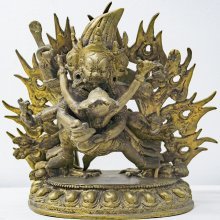
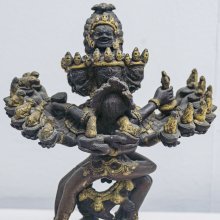
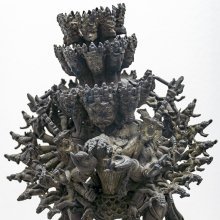
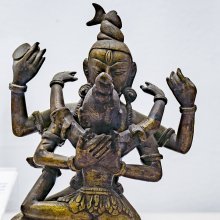
.jpg)
